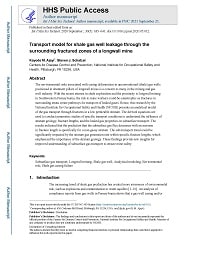Mining Publication: Transport Model for Shale Gas Well Leakage Through the Surrounding Fractured Zones of a Longwall Mine
Original creation date: September 2021
Authors: K Ajayi, S Schatzel
The environmental risks associated with casing deformation in unconventional (shale) gas wells positioned in abutment pillars of longwall mines is a concern to many in the mining and gas well industry. With the recent interest in shale exploration and the proximity to longwall mining in Southwestern Pennsylvania, the risk to mine workers could be catastrophic as fractures in surrounding strata create pathways for transport of leaked gases. Hence, this research by the National Institute for Occupational Safety and Health (NIOSH) presents an analytical model of the gas transport through fractures in a low permeable stratum. The derived equations are used to conduct parametric studies of specific transport conditions to understand the influence of stratum geology, fracture lengths, and the leaked gas properties on subsurface transport. The results indicated that the prediction that the subsurface gas flux decreases with an increase in fracture length is specifically for a non-gassy stratum. The sub-transport trend could be significantly impacted by the stratum gas generation rate within specific fracture lengths, which emphasized the importance of the stratum geology. These findings provide new insights for improved understanding of subsurface gas transport to ensure mine safety.

- Advances in Grid-Based Numerical Modeling Techniques for Improving Gas Management in Coal Mines
- Commercial-Quality Gas From a Multipurpose Borehole Located in the Pittsburgh Coalbed
- Demonstration of Safety Plugging of Oil Wells Penetrating Appalachian Coal Mines
- Gas Sorption and Transport in Coals: A Poroelastic Medium Approach
- Improved Methods for Monitoring Production From Vertical Degasification Wells
- The Limiting Oxygen Concentration and Flammability Limits of Gases and Gas Mixtures
- Prediction of Longwall Methane Emissions: An Evaluation of the Influence of Mining Practices on Gas Emissions and Methane Control Systems
- Reconciling Longwall Gob Gas Reservoirs and Venthole Production Performances Using Multiple Rate Drawdown Well Test Analysis
- Stability Evaluation of Active Gas Wells in Longwall Abutment Pillars
- A Technique for Measuring Toxic Gases Produced by Blasting Agents